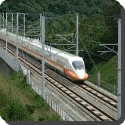 For many years railway engineers have been thinking about new kinds of track for trains to run along. The parallel metal rail tracks with which we are familiar are not very efficient by modern standards. Because wheels are needed to move the trains along, a good deal of power is lost through friction in the moving parts. Ordinary railway tracks also set a limit to the speed that trains can go, especially round curves. They take up a lot of room, and they are expensive to build and keep in good repair.
For many years railway engineers have been thinking about new kinds of track for trains to run along. The parallel metal rail tracks with which we are familiar are not very efficient by modern standards. Because wheels are needed to move the trains along, a good deal of power is lost through friction in the moving parts. Ordinary railway tracks also set a limit to the speed that trains can go, especially round curves. They take up a lot of room, and they are expensive to build and keep in good repair.
Some trains, such as those operated on the Paris Metro, run very efficiently on rubber tyres. Other even more interesting advances in this field have been the experiments with monorail systems. Monorail means ‘one rail’, and several types of train have been designed which are suspended from an elevated monorail track. Spectacular results, in terms of speed and comfort, have been achieved.
Yet other trains have been built which sit astride a single metal or concrete track and slide along it. Called aerotrains, they have been designed to move like hovercraft. Their weight keeps them safely close to the rail or track, but they can glide along a ‘cushion of air’. An even more advanced idea is to suspend a train from a monorail by magnetizing the rail. In all these cases there is hardly any friction to overcome, and much greater safety.
New forms of motive power are also being considered, including jet propulsion. The day may come when trains will be able to move almost as fast as aircraft.
 Kids Portal For Parents India Kids Network
Kids Portal For Parents India Kids Network






